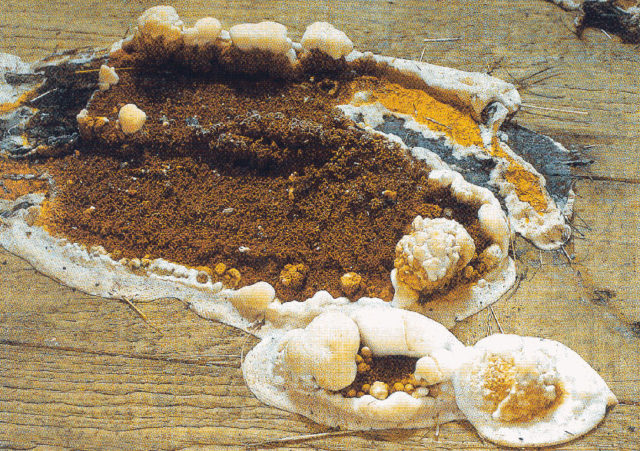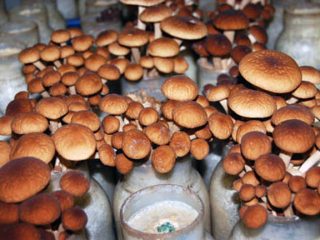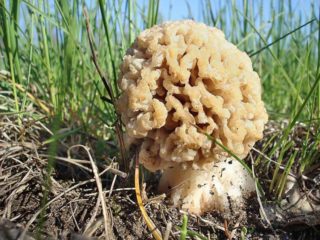Content
The house mushroom is a harmful representative of the Serpulov family. This species settles on wood and leads to its rapid destruction. It often appears in damp, dark areas of residential buildings. The fungus grows quickly, turning wood into dust, so when the first symptoms of infection are detected, it is necessary to begin the fight.
Description of the house mushroom
The white house mushroom at a young age appears as numerous whitish or light gray dots, which grow together over time, forming a wide, oval shape. The surface becomes covered with mucus or acquires a woolly coating.
At the initial stage of development, the fruiting body is snow-white; as it grows, the color changes to red-yellow or brown-rusty. The tough pulp has a layered, rubbery structure.
To recognize the house mushroom in a timely manner, you need to look at photos and videos.

The size of an adult specimen can reach a meter or more
Features of reproduction
With sufficient light, the house mushroom forms the main fruiting body, ready for reproduction. On the upper folded surface of the mushroom, elongated spores form in the form of a rusty powder. Spores can spread to neighboring buildings by wind, animals, insects, through clothing and shoes.
Another method of infection is associated with mycelium, when healthy and infected wood come into contact with each other.
The effect of house fungus on wood
The house fungus is considered a parasite and lives on both coniferous and deciduous wood. It is able to grow and develop under the most unfavorable conditions:
- at low temperature;
- high air humidity;
- with poor ventilation;
- in the absence of natural light.
This environment allows the fruiting body to develop quickly and secrete enzymes that lead to the rapid destruction of wood. Over time, the fungus becomes leaf-shaped, and the infected wood becomes brittle and loose. Destroyed wood turns brown, becomes covered with a whitish coating and easily crumbles under your fingers.Then, with the help of filamentous processes, the fungus penetrates the wood pores, thereby increasing the affected area.
The house parasite does not affect all tree species. It develops well on pine, but is extremely rare on larch and spruce. Acacia, oak and chestnut are resistant to damage, so they are perfect for construction work.

House mushroom can destroy a house in a few months
Why does house mushroom appear in the house and buildings?
House porcini mushroom often appears in humid places and in rooms with poor ventilation. Rapid reproduction also occurs when soil comes into contact with the floor and when new wood is used together with contaminated building material.
Causes and signs of infection
The house mushroom begins to bear fruit under favorable conditions. When the first signs appear, it is necessary to begin treatment, as the fungus grows quickly, turning the wood into dust. Conditions for rapid reproduction:
- humidity 80% or more;
- air temperature + 24 °C and above;
- lack of sunlight.
Most often, the mushroom can be found in basements, cellars and baths. Infection can occur through tools or work clothing that are contaminated with spores.

The parasite appears in damp areas
Positive factors for the development of fungus:
- A stuffy, unventilated place - closed windows, poor ventilation help the house fungus to grow and develop quickly. This is especially true for places where condensation accumulates: kitchen, bathroom.
- Leaking pipes lead to increased humidity and mold growth.
- Freezing of walls, leaking roof, lack of heating.
- The close location of groundwater leads to rotting of wooden pillars and foundations.
Why is the appearance of white house mushroom dangerous?
The house fungus is very easy to detect, so when the initial symptoms appear, control measures need to be started. What signs can you use to detect a parasite:
- A lump of white threads appears on the wood, resembling airy cotton wool.
- As it grows, the fruiting body expands and turns brown-yellow with a silvery tint.
- The tree becomes covered with cracks, acquires a dark color and loses strength.
- The house fungus turns 4 cm of wood into dust in 30 days, and completely destroys the building in 12 months.
Harm of house mushroom to humans
In addition to the rapid destruction of wood, the house fungus causes harm to the human body. Most often, children and elderly people with weakened immunity suffer from it. The first signs of poisoning are:
- headache, dizziness;
- conjunctivitis;
- rhinitis, laryngitis;
- nausea;
- exacerbation of asthma;
- allergic cough;
- pulmonary diseases.
How to deal with white house mushroom
You can get rid of house fungus only in the initial stages of infection. Remedies for controlling house parasites:
- Antiseptics. Effective means for destroying house fungus are broad-spectrum fungicides. But it must be remembered that they have a toxic effect on humans and animals, so the treatment is carried out in work clothes, a respirator and rubber gloves. After the manipulations, the room is ventilated for 24 hours.Often used: a mixture of wood and coal tar, carbolineum and petroleum.
- Mechanical method. This method allows you to destroy the mycelium of the house fungus at different stages of development. At the initial stage of infection, the top layer of wood is removed and burned, and the surviving tree is disinfected with an antiseptic. With deep penetration of the fungus, only removing all infected elements and then treating the edges helps.
- Disinfection. Ultraviolet irradiation is a simple, safe method of combating house fungus. It does not harm the environment, animals or humans. Quartzization of the room should be carried out regularly, since a strong dose instantly kills the fungus and its spores.

Antiseptics - save wood from destruction
There are also traditional methods of combating house parasites. These include:
- an aqueous solution of copper or iron sulfate;
- sodium fluoride solution;
- working solution prepared from vinegar and copper sulfate;
- drug Pentabos.
Prevention measures
Ancient builders always used resinous, oiled and salted wood, as it preserves the wood structure for a long time. In ancient China, before building a house, wood was soaked in an aqueous solution of table salt. It is very effective to coat building materials with creosote, but the product has one drawback - a persistent pungent odor.
To save buildings from house fungus, it is necessary to carry out preventive measures in a timely manner. These include:
- If buildings have been treated for house parasites, it is necessary to thoroughly treat tools and work clothes after finishing the work.
- During construction, contaminated wood should not be used, as the fungus can quickly spread to healthy building material.
- Floors should not be in contact with the ground. Therefore, before laying the floor, a construction pad is made of sand, broken brick or large expanded clay. You cannot use materials rich in humus: coconut shavings, ash.
- For construction, only dried wood is used, treated against house fungus with special antiseptics.
- The constructed wooden house must dry well, after which the wood can be coated with oil paint.
- The cellar and basement should be well ventilated.
- It is not recommended to lay floors close to the walls.
- During the construction of a wooden house, it is necessary to organize air draft under the floor.
- To reduce humidity in the room, you can place several aspen logs in the corners, since aspen absorbs moisture well.
- It is better to carry out the interior finishing of a bathhouse, cellar and basement with boards pre-treated with a hot solution of copper and iron sulfate.
Conclusion
House fungus is a dangerous wood-destroying parasite that destroys wooden buildings in a short time. When the first signs of infection appear, it is necessary to immediately begin control measures, choosing the most appropriate method, and then regularly carry out preventive measures.








